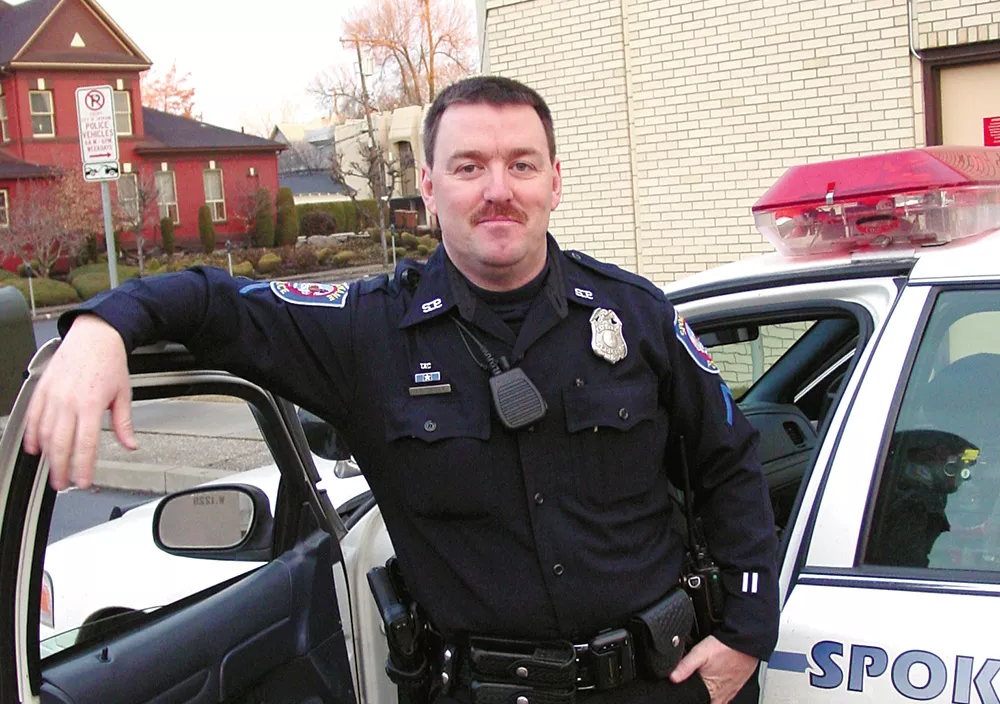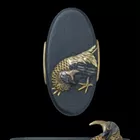
Some days, Spokane Police Officer John Gately has to look for trouble; other days, trouble finds him. The morning of Sept. 22, 2003, was shaping up like another slow day for the 13-year veteran of the force, but then a call came over his radio: Disturbance at a local high school.
A police dispatcher ordered one patrol car to respond. Gately, who had been on his way to help serve a search warrant, decided to turn around and began racing toward Lewis and Clark High School in downtown Spokane. It was 11:10.
"That warrant can wait," Gately recalls thinking as he pointed his cruiser toward the school, sirens blaring. For the first time, over 10 hours of interviews, Gately has reconstructed that day and its aftermath.
He wanted to be among the first to arrive at the school. He knew that the responding officers had received SWAT training, which would dictate their tactics: Rush in, swiftly confront the source of disturbance and corral it, by force if necessary. But as an experienced crisis negotiator, Gately hoped to intervene and defuse the situation before anyone got hurt.
There was no way Gately could have anticipated what he would encounter. He had never heard the name Sean Fitzpatrick. Nor did he know that the 16-year-old boy had left a long note at home bidding farewell to his family and to his dog, Knight. It seemed no one was aware of Sean's torment.
As the 37-year-old negotiator hurried west toward the school, the voice of another police officer came over the radio. It sounded incredulous, Gately thought. Simply to know that his ears had not deceived him, the officer asked the dispatcher to repeat the previous alert. So once again over the air, to every police officer with a radio turned on, the dispatcher related the few known details of the emergency:
Boy with a gun. Shots fired. Possible hostages.
Sean gave no sign that anything was wrong on the night before, say his parents, Angel Fitzpatrick and Linda Schearing, in their first interviews since the incident. They say Sean went to sleep early and at one point rose to go to the bathroom. Before returning to bed, he visited his parents' room. They were still awake, and he kissed them goodnight.
"It's not like there was a lot of warning," his mother says.
The following morning — his father's 52nd birthday — Sean woke and packed his lunch. Unbeknownst to his parents, he also placed two letters in his bedroom next to a pile of cash. It was allowance money Sean had squirreled away, one of the letters explained, and the boy hoped it would cover the expense of burying his body. In his backpack, he carried a loaded pistol that belonged to the family, according to the police investigation.
Sean then secretly swallowed 30 over-the-counter pain pills and hopped in a car with his father, who drove him to school. The trip from the family's farmhouse in Fairfield, south of Spokane, took 45 minutes. He arrived on time and went to class.
Later that morning, at 11 o'clock, Sean entered Room 307, a third-floor science classroom, and instructed Marjan Khoee, a student teacher, to "get out." He showed her the gun and she reluctantly obeyed. Three students remained in the room, unaware of what had transpired. They sat at a table eating their lunches and doing homework through the break period. Among them was Kayla Fields, 17, a junior.
Sean approached the students and in a calm, quiet whisper, directed his instructions to a boy sitting near her, Fields recalls. She stopped eating her submarine sandwich and could just make out the conversation:
"Leave."
"Why? What are you talking about?" the boy asked.
Sean then revealed the gun.
"What's that?"
Sean repeated the order and when the boy did not comply, he drew the gun and fired a single bullet, Fields says. It harmlessly struck a cabinet.
"Man, why did you have to go and do that?" said the boy, who stood up and strode toward the door.
Fields remembers thinking that it must be a prank, that it must be only a powerful cap gun because she never heard a bullet casing clink against the tile floor. That incongruity stuck in her mind. "I'm going to kick your butt," she thought. "You're stupid for bringing that to school."
Finally the gravity of the situation hit. "Maybe I'm a hostage now," she considered. With that, a teacher entered through a side door that connected to an adjacent classroom. Sean trained the gun on the teacher, Fields says, and she and the other student started for the hall. The teacher closed the side door and retreated, too.
Looking over her shoulder, Sean appeared at ease, Fields recalls: "He was just sitting — really calm, really laid-back, really casually lounging. He didn't look angry or sad or upset. He was smart. He knew what he was doing."
As Fields escaped into the hallway, the door swung shut behind her.
Officer Gately pulled up in front of the school about five minutes later, right as the first two-officer unit arrived. From the trunk, he promptly grabbed a ballistic helmet, a 12-gauge shotgun with beanbag rounds and a Colt AR-15, a semiautomatic version of the M-16 rifle used in the Army. "Just in case," he recalls thinking.
Students were streaming out of the school and onto the sidewalk and streets. The fire alarm was ringing. Gately can still see their faces, creased with confusion, fear welling in the teens' eyes.
"They see what you put on, and they kind of go, 'Whoa,'" recalls Gately.
Gately strode up the front steps with the other officers. There were five of them now inside the vestibule. Officer Kevin Keller, a trained SWAT member, talked with the school security officer and Principal Jon Swett. Keller learned of Sean's name and his approximate location, somewhere among two or three rooms on the third floor. Gately appointed the other officers a position in a diamond formation: Keller at the front, Officer Alan Edwards to the left, Gately to the right and Officers Stephanie Kennedy and Nate Spiering covering the rear point.
Just as they had trained for such an event, the team moved out as one. The five officers marched through the hallways shouting at lingering students to get out of the building. They ascended the stairs while dozens of other officers combed through the lower floors. At the crest of the third flight of stairs, Gately cried out, "Sean, Sean."
Within seconds, the door to Room 307 creaked outward into the hallway. It was 11:23. Just inside the threshold stood a small, waist-high barricade consisting of a filing cabinet and short bookshelf, Gately says. And beyond that, framed by the open door, was Sean Fitzpatrick. He wore cargo pants and a black T-shirt with some sort of face printed on it. In his right hand, clearly visible to Gately, was a 9-millimeter handgun — a model often carried by law enforcement.
Sean stood about 15 feet away. "He said we got there too fast," Gately recalls. "We interrupted him. What he meant by that, I still don't know."
The letters Sean left behind provide a glimpse of a boy overwhelmed by life, the police and his family say. Detectives discovered them several hours after the incident on top of a box of Legos in his bedroom. One ran a page and half long; the other, much shorter. Police Chief Roger Bragdon says the letters confirm Sean had been considering suicide for some time and that he believes the boy wanted the police to do it for him. Bragdon adds that he believes Sean did not intend to hurt anyone else. His family does not dispute the chief's interpretation.
Schearing, Sean's mother, disclosed the shorter note during an interview last week. It reads: "I'm so sorry, for I loved you all so much, but I could not bear the pain. I tried, I really did. I love you all so much."
The other letter, his parents say, was a son's long goodbye message to his family. He addressed each member: Mom, Dad, his two sisters and Knight, a black Labrador. Scattered throughout the final farewell were cryptic, seemingly nonsensical comments, according to several people who have reviewed the letter. In light of an extensive psychiatric evaluation undertaken since the incident, the comments appear to have been caused by "auditory hallucinations" echoing in Sean's head, says Carl Hueber, the family's attorney. Such hallucinations are often symptoms of mental illness, but a formal diagnosis has not been finalized.
Hueber says an independent clinical psychologist has concluded that Sean heard voices several times a day for more than two years before Sept. 22. He never revealed his affliction to anyone, Hueber says, but he wrote about them in a private journal that has since been found. A copy of Sean's mental assessment has been turned over to Prosecuting Attorney Steve Tucker, who is considering whether to file criminal charges in the case.
"When Sean could no longer tolerate the voices," Hueber says, "he decided to take his own life."
Yet, in the moment that Gately spotted Sean through the doorway, there were only two facts available: The boy's name was Sean and he had a loaded gun.
Gately took off his ballistic helmet and gave his shotgun and rifle to other officers. He looked Sean in the eyes; only a police officer kneeling behind a shield was between him and the boy's gun. He needed to make the conversation personal. That is the first rule of negotiating: Talk as a human being, not as a cop or an adversary. But where do you begin? And how can you avoid those perilous Do Not Touch buttons?
With nothing to go on but instincts and training, he launched in. According to Gately's account, gathered over several hours of interviews, the 80-minute standoff went like this:
In a friendly, "I'm just a guy" voice, Gately began, "Hey, Sean, what are you doing?"
Gately inquired about the gun. Sean had been fidgeting with it — switching the pistol between hands — but by his grip, it appeared that he knew how to carry it, Gately thought.
"Don't touch it. You can't have that in your hand."
"This? Don't worry about it," Sean replied.
Gately asked him why he had fired the gun into the cabinet.
"I wanted them to know I'm serious."
"OK, Sean. We know it. We know it."
The negotiator fished for a "hook," something to grab the boy by the collar and pull him back from this ledge. Since Sean was a high school junior, Gately asked about girls. No luck. Then family. He divulged his parents' names and the fact he has a younger sister who also attends the school. Gately filed this information away in his head and dispatched another officer to look for the girl.
Finally the fire alarm went off and the school turned quiet. Just their two voices and the distant thud of doors, signaling new reinforcements marshalling throughout the school. Sean heard the echoes, and the negotiator changed the topic.
Gately deduced early on that Sean understood police tactics. It seemed he had a plan. He constructed his barricade before anyone arrived. He quickly asked Gately if he was the assigned negotiator. He sprayed a fire extinguisher into the hallway, creating a potent fog. And later, he requested the "throw phone," a portable receiver that can be tossed to someone during a negotiation.
At different points, Sean retreated from the doorway and disappeared into the classroom. There were clanging sounds. Gately continued to ask questions, trying to determine where Sean was and what he was doing.
He returned to the threshold and Gately implored him, "We don't want anybody to get hurt."
And Sean agreed. "You're right. We don't want anyone to get hurt."
But then, he abruptly switched. "Well, wait a minute. There is one person."
He never said who.
Sean sat down on the filing cabinet, nearly in the hallway, Gately recalls. He set the gun by his leg, but never took his hand off it. He looked up. Gately sensed that he had hooked Sean and started to reel him in.
"You don't have to do this," he said. "We can figure this out. You and I."
The boy appeared to be listening.
"Come on out. We'll just sit here and bullshit on the steps. OK?"
Sean moved for the door and neared the threshold. This was it, Gately thought. But then — maybe it was the sight of more officers in the hall — Sean fled back into the room. Gately did not understand how "he wiggled off the hook." He said that on two or three occasions, Sean neared the point of surrendering but at the final moment turned back.
The conversation continued.
"My dad's here."
"How do you know that?" asked Gately, himself unaware that Angel Fitzpatrick was indeed being kept in a nearby building.
Then, around 12:45 pm, 80 minutes after he first started talking to Gately, Sean's manner changed — and Gately could not understand why. The boy's movements became very slow and deliberate. He pulled on a windbreaker. Gately lost track of where the gun was; apparently, so did some of the officers on either side of the door.
Gately shouted. "Sean!"
Next, the boy climbed up the barricade, stepping on the shelves of the bookcase in front of the filing cabinet. Before he reached the top, he pulled the pistol from his cargo pants and pointed it toward the officers, Gately and other officers say. In response, according to the police account, three officers took aim.
Fifteen shots were fired, the police say, none of them from Sean.
Sean was hit three times — including one bullet in the face — and his body fell back into the classroom as five or six officers charged the door. Gately's one thought was to get to Sean and talk to him.
As Gately dropped to the boy's side, Detective James Collins, who has EMT training, reached down Sean's throat and pulled out pieces of teeth, bone and pulverized tissue. He needed to create an airway. Sean's eyes were closed and he thrashed about the floor. Collins rolled him over and blood drained from the hole in his face.
"Come on, Sean," Gately pleaded. "Breathe. You've got to fight, you can't give up."
Gately received orders to leave the room, but he refused. "I'm not going nowhere," he said, then waited until medics arrived.
Sean was whisked in an ambulance to Sacred Heart Medical Center a half mile away. His condition was so grim when he arrived that he was administered the last rites, says his father, Angel Fitzpatrick, who arrived at the hospital soon after Sean did. Doctors struggled to staunch the bleeding and steady his blood pressure.
The bullet that hit Sean's left cheekbone shattered into countless metal splinters, destroying part of his palate, teeth, tear ducts and left sinus. One shard severed a vein at the back of his tongue that would not close.
Sean lost 12 pints of blood that day before doctors could stabilize him, his father says. A bullet also struck Sean's right forearm and another passed through his abdomen, left to right above vital organs.
Shortly after the shooting, the police tracked down Sean's mother at Gonzaga University, where she is a religious studies professor, and drove her to the hospital.
"Part of the time I was numb because of the unreality of everything," Schearing recalls. "It was hard to believe what had happened had actually happened. It was like walking around in a nightmare."
While Fitzpatrick and Schearing awaited updates from ER doctors, they answered questions from police detectives. They said they were baffled. They could not fathom the actions of their son — a boy they knew for his dry wit, his love of sci-fi books and his generous nature.
The next few days blurred together. Surgery after surgery. Hour after hour in the waiting room. They would get a few moments of sleep at a motel down the road and then return to the hospital. Sean was comatose. Doctors wired his jaw shut and later had to reopen it when they discovered he had partially swallowed a chunk of cheekbone, his parents say.
He was fitted with a tracheotomy tube so he could breathe from his neck, and the rest of his head was wrapped in white bandages, leaving only his nose and lips exposed. His head swelled to size of a basketball, Fitzpatrick says.
They waited and prayed. Sean stayed in intensive care for 12 days, and when his condition finally became stable, his father went to his side. Fitzpatrick leaned over the bed, brought his head close to Sean's and whispered.
"Sean, I love you," he said, "and there's nothing you can do to stop me from loving you."
The boy squeezed his father's fingers.
Gately did not know what to do after Sean was taken to the hospital. That was the problem, he says; without something to occupy his mind, he would have to think, obsess and second-guess the shooting.
He wandered the halls of the school for a few minutes and then was shuttled to police headquarters. Chief Bragdon explained what would come next: The police and Sheriff's Department would jointly investigate the shooting, as is routine when officers fire their weapons. The three officers who simultaneously shot Sean, Sgt. Troy Teigen and Officers Kevin Keller and Daniel Lesser, were put on leave for three days, as was Gately — again, as standard procedure.
Gately could not sit still. He walked out of the conference room and down the hallway. Adrenaline was surging through his body, he recalls. He had been through this process before. In 1995, he and three other officers shot a mentally ill man who had barricaded himself in his mother's bathroom and then charged at officers with a shard of broken mirror. Gately says the experience hung over him for four years until a civil-court jury finally cleared the officers of any liability.
Gately needed to do something — anything — and since working was off-limits, he looked for a diversion. There was department softball game that night and he decided, "I gotta go."
He coached and played third base and shortstop. Thankfully, it was a doubleheader.
Once while in intensive care, Sean tried to pull out all the wires and tubes connected to his body. He tried to end his life, to finish the destructive process he had initiated, his parents say. He was put on 24-hour suicide watch; for the next five weeks, hospital staffers took shifts sitting in his room.
In the beginning, Sean was only semi-conscious because of the heavy doses of medication. His head remained wrapped like a mummy's, and he could not talk. He communicated by squeezing his parents' hands and later used a white board and markers. In the beginning, Sean could not recollect what had happened, his parents say. He asked whether he had been involved in a car wreck.
"Is this heaven?"
"Hopefully not," his father answered.
His parents were advised not to correct him, not to implant memories, but to allow them to return on their own. And as the dosage of morphine declined, Sean did remember.
"He asked, 'Did I hurt anybody?'" Fitzpatrick says. "That was the first thing he asked, 'Did I hurt any of the police?'"
Sean endured several surgeries, including one where doctors harvested bone from his hip and implanted it in his cheek. They had to slice through his scalp, peel down his face and attach the new bone with metal plates.
As Sean healed, he started to forge bonds with the hospital staff. He always had company and would play chess or penny poker with visitors. He won often.
He also began counseling, and staff from the hospital's psychiatric ward visited him, his parents say. As soon as doctors permitted Sean to leave his bed, his father took him to Catholic services inside the hospital. At first, Fitzpatrick slowly rolled Sean along in a wheelchair, with steel trees of tubes and IV drip bags trailing behind. Later, Sean would walk to Mass but still could not receive the Eucharist, as he was fed through a stomach tube.
Finally, in early November, doctors cleared Sean to leave the hospital. It was a moment for celebration, but it sent tremors of fear through his parents. If Sean leaves, would the police come to the house and arrest him? And how would they manage to provide care? His bullet wounds had not healed completely, and with a tracheotomy tube, even a mucus clot could kill him.
The departure was tense and bittersweet, his parents recall. The doctors and nurses had become part of the family. Sean felt connected. As the final hour approached, hospital staff filled Sean's room and formed a long line down the hallway. Some were crying. They presented Sean with a brand-new chess set and said goodbye. For the first two weeks after the shooting, Gately thought of little else. He could not help it, he says, the memories would stubbornly surface. "Just a constant videotape," he says, "and when you wake up, it's playing in your head."
Spending time with his children offered some relief. He has a 9-year-old boy and 11-year-old girl — they live with their mother two miles away — and they would go to the park, hang out or ride bikes together. By mandate, he had to visit the department's psychologist, but he first opened up about his feelings to a complete stranger, a new recruit.
On his second day back on the job, Gately was given a new officer to train. It allowed Gately to return to familiar territory — patrolling the south side of Spokane — and he used the recruit as a sounding board. "He was somebody that I could play things off of in the car," Gately recalls.
Gately eventually began to sleep better. Trained in "critical incident stress management," Gately understands trauma. After the terrorist attacks on the World Trade Center, he traveled to New York City to counsel police officers there. Their stories stuck with him. Gately is all too aware of the facts: More than half of police officers involved in shootings leave the job within five years.
When the time came to leave, Schearing exited through the front door of the hospital, lugging some of Sean's belongings. She was a decoy for the news reporters. Sean and his father meanwhile snuck out the back of the building and drove the 30 miles home. It was Nov. 6.
The prospect of caring for Sean terrified his parents. He was fragile. Any infection in his mouth — even tooth decay — could endanger his life. One of them had to watch him every moment of every day. They arranged him a bed in the living room and slept on the floor and couch beside him. It soon resembled his former hospital room, with drawers of bandages, tubes, syringes, saline solution and a suction machine to clear Sean's throat.
Early on, it seemed that not a day went by without a crisis. Sean could not swallow, so without warning he would stop breathing and turn blue when saliva lodged in his tracheotomy tube. Other times, Sean would inject fluid supplements into his stomach port too quickly and then vomit in full-body convulsions.
"For him to throw up right now is the scariest thing you've ever seen," Schearing says.
Slowly, he grew stronger. His wounds healed, his scars shrank. He played fetch with Knight and did mall-walking with his father. He continued psychiatric treatment. Newly prescribed medication leveled out his moods. In early January, doctors removed his tracheotomy tube, enabling Sean to form a few words and drink small amounts of liquids.
His parents decided to store treats and little gifts in a large plastic tub, everything their son had missed along the way. "Sean's Stash," as it is called, has stockpiled candy from Christmas, Valentine's Day and regular trips to the grocery store. In the freezer, they keep a turkey leg from Thanksgiving.
Driving home from Spokane about a month ago, Fitzpatrick wanted to surprise Sean: He leaned over and offered to buy some soft-serve ice cream. They stopped and Sean ordered a small bowl, his first food since Sept. 22.
"He takes a spoon, brings it in his mouth," Fitzpatrick recalls. "You can see the joy on his face, and his eyes just kind of roll back and he's feeling it on his tongue."
Sean tilted back, and the cool, melted cream dripped down his throat.
Officer Gately wore a smart wheat-colored suit and a sober expression as he entered the Avista Utilities Auditorium on Feb. 11. It was the police department's annual award ceremony. Those men and women who first responded to the school were to receive Silver Stars for bravery, yet many of them had to be convinced to attend. Chief Bragdon told the officers to accept the honor for their families, if for no other reason.
Before the ceremony began — before the singing of the national anthem, before the solemn invocation by a chaplain — Gately shrugged off questions. "I was just doing my job," he said.
The truth is, when Gately allows himself to reflect, he still tries to figure out if he could have done something differently. A negotiator's sole purpose is to defuse a crisis, pull people back from a precipice, save their lives and protect the officers involved.
He sat at the end of a row surrounded by friends and family. His facial muscles were taut and his expression indiscernible as Spokane Mayor Jim West rose from a chair onstage and approached the lectern. There were 200 people in the audience.
"Congratulations to the entire department for the work you do everyday," Mayor West said, "so we don't have to think about what you do but can go on with our lives and live in peace."
As the other awards were announced and delivered — including the Lifesaving Medal to Detective Collins, who cleared Sean's airway — Gately stood up with the audience and clapped passionately for his colleagues. He patted officers on the back as they descended the aisle.
The Silver Stars came last, and before Bragdon read off the names, he wanted to remind the audience exactly what these officers had faced.
"On September 22, 2003, we had our own nightmare: the Lewis and Clark shooting," Bragdon said. He described the first thought that had raced through the minds of everyone in the department — Columbine High School in Colorado — and how police officers at that shooting had been trained to "contain, control and communicate" with gunmen.
But now, in the aftermath of that shooting where 12 students and a teacher were killed, tactics have changed. Today, police officers no longer wait outside; instead, they race toward the threat and confront it.
"When the call went out," Bragdon continued, "there were between 1,000 and 2,000 students. Some of them were getting out. Some of them didn't know what was going on, and somewhere in the middle of that was a shooter."
Gately said later that as he anticipated his award, the mental videotape of his talk with Sean started to play on a loop. He relived it. When his name was called, Gately walked onto the stage and received his star. No smile, his eyes cast down.
After the ceremony, Gately lingered for a few moments, congratulated other officers, shook a few hands and then silently slipped away.
Last week, in the downtown law office of Winston & Cashatt, on the 19th floor of the Bank of America Building, Sean sat motionlessly next to his father. Across the wood conference table were his mother and his attorney, Carl Hueber. The family posed for photographs and, for the first time, both his parents and Sean spoke together about what had happened.
Sean had something he wanted to say. Without portions of his upper palate, his speech was mumbled and soft, as though he were talking with a mouth full of food. "I didn't mean to harm anyone but myself," Sean said quietly.
He then answered a series of questions, responding with one or two words or none at all. How are you feeling? Fine. How important are your parents? Very. Do you miss school? He shakes his head. What now? I don't know.
In many ways, Sean lives like an average teenager. He plays video games and watches TV. He likes rock music, especially Linkin Park, and favors science-fiction movies.
Sean listened intently as his parents recounted his short life. They said they were aware that he had seemed depressed, but attributed it to growing up in modern times, being a teenager, wearing his heart on his sleeve. (His parents did not disclose Sean's psychiatric evaluation during this meeting; Hueber released those details the next day.)
Still, in hindsight, his parents say they should have recognized his "sleep inversion" — staying up late, napping through the weekend — as a sign of serious problems.
"Sean, I'm talking as if you're not here, and I apologize," Schearing told him at one point.
His parents continue to replay the last days before Sean decided to bring a gun to school. They wonder what tipped the scale, what transformed him from a troubled teenager to someone who desperately wanted to die. The week before, Sean's portable CD player was stolen at school and he thought he failed an exam. A week before that, Sean saw two movies involving the police: S.W.A.T and Phone Booth. Was that it?
Sean did ask his father about suicide on one occasion, and they talked about God's view of people who end their own life. "I never thought anymore about it, until this," says Fitzpatrick, a former United Methodist minister who is now studying to become an accountant.
When pressed on whether Sean should be charged with a crime — prosecutors are considering second-degree assault and weapon charges — Fitzpatrick pointed to his son, saying "Look at what he's living with and will have to live with for some time."
In addition to psychiatric treatment and speech therapy, Sean faces numerous surgeries over the next two and a half years, his parents say. Doctors will try to realign his jawbone, reposition his left eyeball and reconstruct his left sinus. He will also be fitted with a prosthetic over his palate, enabling him to eat and enunciate words.
His parents fear that Sean will try to hurt himself again. He has endured so much, they say. On Saturday, he will turn 17.
"What I want for Sean is I want him to be happy. I want him to find something," Schearing said, stopping and turning to address Sean across the table.
"I want you to find someplace, a niche where it's all your own, and you'll be happy," she said to her son. "That's all I wish."
Sean returned her gaze and smiled.
Last Thursday, Officer Gately pulled the squad car out of the department's underground garage and started another tour of duty. It was just after 6 o'clock in the morning and the night sky had finally begun to fade. He prefers the day shift, he says, because when the sun is up, people tend to wave more than one finger when he drives by.
The first call: Someone had dialed 911 and hung up. Gately drove down side streets and, using the car's computer system, searched the police history at the address. The woman who lived there was mentally disturbed and often called the police.
When he arrived at the house, another officer pulled up and the two of them climbed a dark enclosed staircase to the woman's apartment. Each of them put a hand on his gun.
Gately called out the woman's name. "Come open the door," he shouted. "Just let me know that you're OK."
The woman called 911 again, reporting that someone was knocking on her door. Gately then peered through a hole — he could see the woman was uninjured — and decided there was nothing more to do but take another call.
It was a slow morning by police standards. He checked on a report of a stolen vehicle and ran the license plates of suspicious-looking cars. Later, he helped to arrest a prostitute with outstanding warrants and backed up officers in the middle of tenant-landlord dispute.
For all its tough moments, Gately loves being a police officer. Waking each day not knowing what it holds is the appeal of police work, he says. "When all heck is breaking loose, I want to be standing right dead center in the middle and everybody looking at me, going, 'What do we do?'"
While driving around on patrol, Gately often thinks about Sean and wonders how he is faring. Although Gately believes Sean should face charges for his actions, he would like to speak with him again someday, under less tense circumstances. He wants to better understand what happened in the hallway of Lewis and Clark High School last fall.
At about 9:30, Gately responded to a call of a break-in at a new downtown club on Pacific Avenue, but the thief had apparently escaped out a back door before police arrived. After looking around the cavernous building for a while, Gately climbed back into the squad car. As he turned the ignition, the radio crackled. Whatever came across the radio next, Gately knew it would be trouble.
Jacob H. Fries is a former New York Times reporter. After spending several months in his hometown of Spokane, he's off again to report on the 10-year anniversary of the end of apartheid in South Africa.










